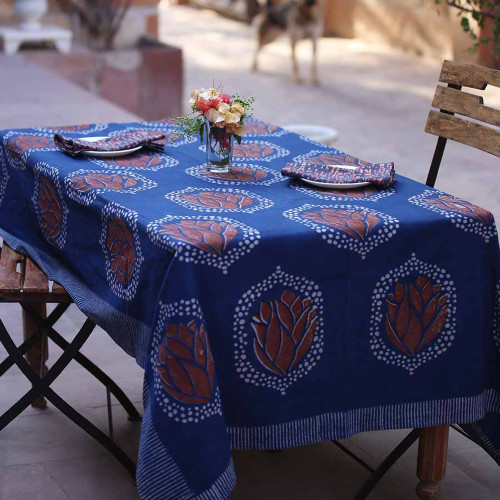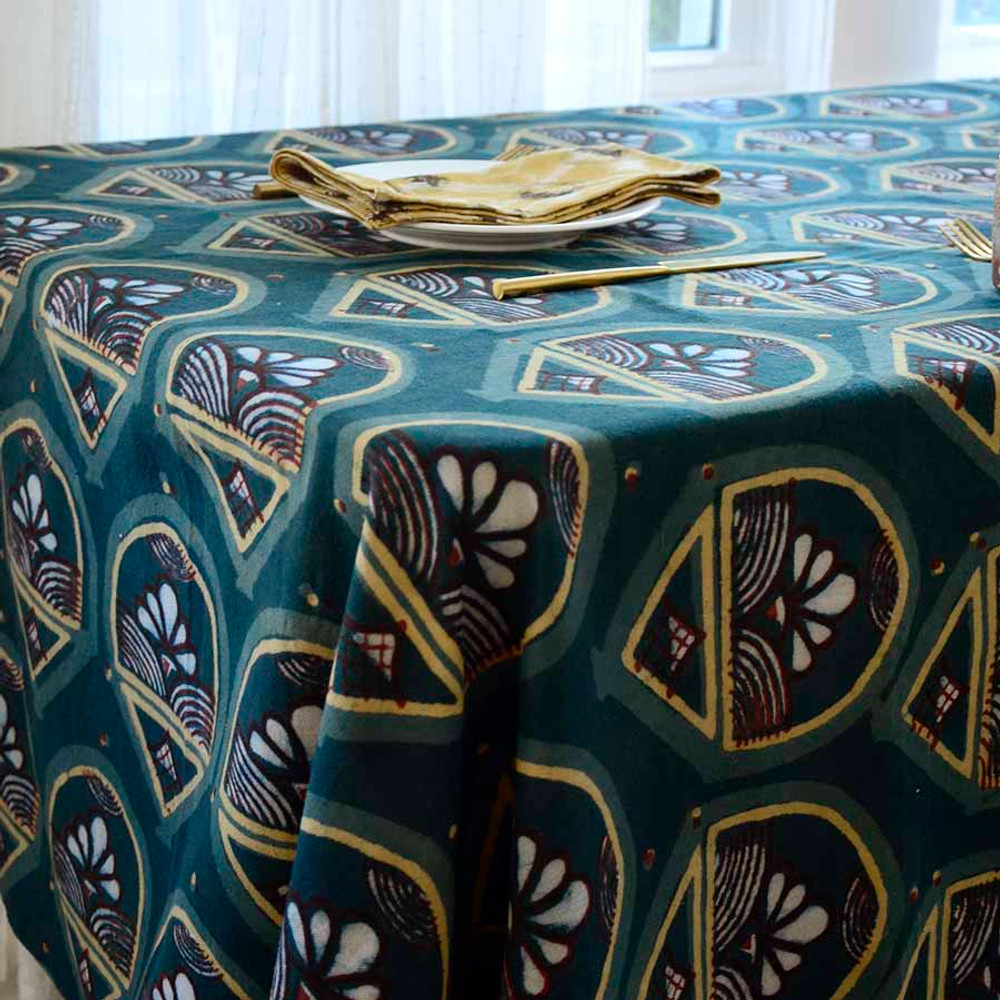Best Fabrics for Tablecloths: Top Materials for Every Event
Posted by The Ichcha Team on 24th Jul 2025
Although tablecloths weren't originally meant as decorative elements (they were actually used to protect the table from scratches), they're now a big deal in how great your table setting turns out. As such, you want to get the best tablecloth fabric that works for your event theme, offers convenience, and suits your style. So, what is the best fabric for tablecloths?
Cotton, linen, polyester, silk, and satin are the best and most commonly used tablecloth fabric materials. But they differ in many ways, from elegance to event suitability and environmental impact.
I discuss the common fabrics for tablecloths below so you can decide which is best for you.
1. Cotton Tablecloths
Cotton is the best tablecloth fabric for everyday use, and the most popular too. Cotton tablecloths drape nicely, aren’t too slippery, and are super machine-washable. And when it comes to sustainability, cotton tablecloths are up there, especially the organic cotton ones.
Cotton is a natural fiber derived from the cotton plant, which means it is breathable and eco-friendly. However, conventional cotton is associated with intensive water use, so if sustainability is a priority for you, opt for organic cotton, as it is more environmentally friendly than conventional cotton. It even feels softer.
Apart from their sustainability, what I like most about cotton tablecloths is they don't easily slip off the table. The natural fibres are also super absorbent in case of any spillage.
These are reasons why I use organic cotton tablecloths at home. If you want some, just head to Ichcha to find premium organic cotton tablecloths, block-printed in beautiful Indian patterns. They're perfect for everyday dining and casual events.
Pros:
- Cotton tablecloths are soft, very comfortable, and highly absorbent
- Machine washable
- Breathable natural fibers
- Affordable and easy to find
- Environmentally friendly (especially those made from organic cotton)
Cons:
- May wrinkle easily if not washed the right way
- Can shrink if not properly cared for
- Stains may need extra effort to remove
Pro tip: read how to wash cotton table linens and prevent wrinkles.
2. Linen Tablecloths
Cotton and Linen are the oldest tablecloth materials, and they remain the most widely used to date. While cotton is best for casual events and everyday dining, linen tablecloths are more suited for formal occasions like black-tie and weddings. One reason is that linen is pretty expensive.
Another reason is that linen just has this premium feel of luxury that the fibers exude.
Linen is made from the flax plant, so linen tablecloths are very eco-friendly. Just note: they do wrinkle and are not as easy to care for as cotton.
If you're an eco-conscious consumer, cotton and linen are the best tablecloth materials you can think of. You'll then have to consider the occasion and your budget to determine which of the two to go for.
Pros:
- Linen has a supremely elegant and timeless look
- Soft and highly absorbent
- Durable and long-lasting
- Made from the flax plant, meaning its biodegradable
- Naturally antibacterial
- Linen is one of the most ecofriendly fabrics ever
Cons:
- Wrinkles easily
- More expensive than cotton
- May require special care or ironing
3. Polyester Tablecloths (Including Organza)
When you want to go cheap while still staying elegant, polyester tablecloths are the practical option. They’re a lifesaver because they resist wrinkles and stains. But that's because polyester is plastic.
Yes, polyester is synthesized from petroleum via a chemical process, so it is the least environmentally friendly fabric for table linen and textiles as a whole.
Notwithstanding, you can't take away how incredibly easy polyester is to clean. For a table linen that gets food stains easily, that's a plus.
If you've heard of the Organza tablecloth, it's made from polyester, too, so I'm not going to create a separate section for it.
Pros:
- Polyester is a highly wrinkle-resistant and stain-resistant tablecloth material
- Very affordable and easy to find
- Durable
- Comes in a wide variety of colors and styles
Cons:
- Polyester tablecloths slip off the table easily
- Less breathable than natural fibers
- Polyester significantly contributes to environmental damage due to its production process, waste generation, and release of microplastics.
- Not biodegradable or eco-friendly
4. Satin Tablecloths
Satin is a great fabric for tablecloths and is perfect for when you want that smooth, glossy, high-shine look: think weddings or holiday dinners.
They catch the light beautifully, but they can be a little slippery and delicate, just like polyester.
In short, many satin tablecloths are made from polyester blends, which means they share some of the same pros and cons.
Pros:
- Luxurious, shiny finish
- Great for formal events
- Good as an outdoor fabric
- Often wrinkle-resistant
- Elegant and eye-catching
Cons:
- Slips off dining tables
- Prone to snags or stains
- Not eco-friendly if made from polyester blends
5. Lace Tablecloths
Lace tablecloths remind me of vintage tea parties and heirloom dining sets. They bring a romantic, delicate feel to any table. I love using lace over a solid tablecloth for layering, as it instantly elevates the look.
However, most lace these days is made from polyester, but you can find cotton or mixed fiber options if you’re leaning green.
I also notice that handling lace requires more care than I find convenient. Washing machines can tear the material. So this tablecloth material is not the best for everyday use.
Pros:
- Lace tablecloths are decorative and add a vintage feel to formal or romantic settings
- Great for layering and special occasions
- Adds texture and elegance
Cons:
- Can snag easily
- Harder to clean (often hand-wash only)
- Requires an underlay or table runner to prevent the see-through effect. This adds extra cost
- Not very practical for everyday use
- Most lace tablecloths are made from synthetic fabrics
6. Silk Tablecloths
Silk tablecloths are the definition of luxury. I’ve only used them on very special occasions, and they’re breathtaking, with a significantly higher price tag than other common fabrics.
If look and elegance are your major requirements, then silk is one of the best tablecloth materials you can think of. The fabric is natural and sustainable.
Silk is derived from silk worms. If cultivated without harming the worms, it's considered ethical and eco-friendly. Otherwise, not so much, even though it's a natural fabric.
The sheen is gorgeous, and silk tablecloths feel like butter — but definitely high-maintenance. Silk is delicate, can stain easily, and typically needs to be dry-cleaned. Notwithstanding, it's a natural fiber, so it scores better than polyester in the eco department.
Pros:
- Silk is incredibly soft and luxurious
- Natural fibres, hence biodegradable
- Drapes beautifully with excellent sheen
- Silk is one of the best tablecloth fabrics for formal settings
Cons:
- Expensive
- Stains and wrinkles easily
- High-maintenance, requires dry cleaning or gentle care
Verdict: What is the Best Fabric Material for tablecloth?
It all boils down to your needs and lifestyle. Cotton is the best tablecloth fabric for everyday use and casual dining, and it scores high on the sustainability scale. The best tablecloth material for formal events like weddings is linen, due to its elegance and luxurious appeal. Silk is pricy and high-maintenance.
While polyester tablecloths are very affordable and common, they cause tremendous harm to the planet, plus they tend to slip off the table.
At Ichcha, we care about your convenience and budget as well as the environment you live in. That's why we offer eco-friendly Indian tablecloths made from 100% organic cotton block-printed and hand-dyed into gorgeous patterns. So you get the rare opportunity to beautify your dining table while preserving your environment.
Check our collection of block print cotton tablecloths.
Frequently Asked Questions (FAQs)
What is the best type of fabric for tablecloths?
It depends on your needs. Cotton tablecloths are great for everyday use, linen brings elegance and luxury, while polyester is practical for events. If you're big on sustainability, linen or organic cotton is a solid choice of tablecloth fabric.
Is linen or cotton better for tablecloths?
Linen is more elegant or luxurious, while cotton is softer and easier to care for, making it best for everyday dining. If you prioritize eco-friendliness and style, organic cotton is an even better tablecloth material than linen and conventional cotton.
What materials are used to make a tablecloth?
Tablecloths are commonly made from cotton, linen, polyester, satin, and silk. Each offers a different look, feel, and suitability for various occassions.
Is scuba better than polyester tablecloths?
Scuba is a type of polyester with a thicker, stretchier feel, often used for fitted or wrinkle-resistant looks. It can be better for certain modern setups, but it lacks the flowy drape of normal polyester.
What are cheap tablecloths made of?
Cheap tablecloths are usually made of polyester and polyester blends. They're easy to make and clean but not very good for the environment.
What is the best material for a white tablecloth?
For white tablecloths, linen or cotton is more suitable as it gives a crisp, classic look, something you'd want in formal settings. Polyester is the next best option -- although, like I always say, it comes at a huge cost to the environment.




